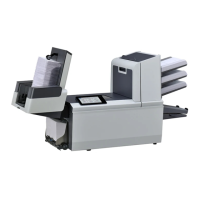
Do you have a question about the quadient DS-77iQ and is the answer not in the manual?
Essential safety requirements and precautions for operating the system.
EU compliance statement for the product.
Overview and disclaimer regarding the manual's content and updates.
Accessing help topics via a pull-down menu and its available options.
Instructions on how to browse, search, and navigate within the user guide.
Details on obtaining online remote assistance from the helpdesk.
Overview of the system as a folding and inserting machine for mail processing.
Visual explanation of the system's components and their functions.
Identification and function of various physical controls and parts of the system.
Description of the touch screen control panel, buttons, and status indicators.
Step-by-step instructions for connecting power and starting the system.
How to interact with the touch screen interface using gestures like tap, swipe, and pinch.
Explanation of what a 'job' is and its purpose in mail processing.
Navigating the job list and viewing detailed information about selected jobs.
Information on High Capacity Document Feeder (HCDF) and MaxiFeeder options.
Details on Vertical Stackers, Side Exit, and Catch Tray configurations.
Description of the AIMS software for progress monitoring and reporting.
Procedure for safely shutting down the system.
Overview of using existing jobs, automatic jobs, and manual jobs for mail processing.
Steps to select and run a previously saved job.
Process for creating new automatic or manual jobs.
Details on how automatic jobs process mail and features not supported.
Step-by-step guide to configure and create an automatic job.
Step-by-step guide to configure and create a manual job.
Configuring envelope type, size, and sealing options for a job.
Configuring document type, number of sheets, and reading options.
Adding and managing enclosures for a job.
Selecting and configuring document fold types for a job.
Configuring the document exit path for a job.
Fine-tuning job processing parameters like flap closer offset and document offset.
Procedure to create and validate a test mail set for job settings.
Adjusting the envelope insert position for correct mail set assembly.
Correcting the address position on mail for visibility in envelope windows.
Fine-tuning document separation for special feeders.
Adjusting the side guides on the MaxiFeeder for optimal document feeding.
Using the Daily Mail function for processing individual mail sets.
Modifying existing job configurations.
Saving newly created or edited job configurations.
Duplicating existing job settings to create a new job.
Removing unwanted jobs from the system.
Changing the name of an existing job.
Preventing unauthorized modification of job settings.
Symbols and instructions for correct document placement in feeders.
Steps for correctly inserting document feeder trays into the system.
Procedure for adjusting side guides on document feeder trays.
Instructions for filling document feeder trays with documents.
Explanation of document separation and its manual adjustment for special feeders.
Adjusting document separation for the MaxiFeeder.
Steps for correctly loading envelopes into the envelope feeder.
Procedure for refilling the sealing liquid reservoir.
Adjusting screen brightness, contrast, and zoom features.
Accessing and configuring operator-specific settings like localization and display.
Accessing advanced system settings and configuration options as a supervisor.
Viewing and modifying system configuration details like serial number and error logs.
Information about installed software versions and components.
Managing software features enabled by license codes.
Configuring system language, document standards, and keyboard layouts.
Adjusting date, time, and screen display parameters.
Configuring how the system handles envelope clearing between jobs.
Fine-tuning job processing parameters like flap closer offset and document offset.
Methods for connecting the system to the internet via wired or wireless connections.
Instructions for establishing an internet connection using an Ethernet cable.
Instructions for connecting the system to a Wi-Fi network.
Verifying the system's internet connectivity status.
Testing network responsiveness by pinging a specific server.
Configuring system statistics sharing and usage warnings.
Configuring server addresses and ports for the AIMS verification system.
Overview of BCR, OMR, and Flex reading codes supported by the system.
Guidelines for printing codes to ensure reliable reading by the system.
Details on Bar Code Reading (BCR) and how it informs the system.
Specifications for Code 39, Code 128, Datamatrix, and QR codes.
Details on Optical Mark Recognition (OMR) and its functions.
Explanation of Flex reading for non-standard codes and custom settings.
Steps to create BCR, OMR, and Flex reading jobs.
Configuration options for reading jobs, including sheet counts and reverse reading.
Routine checks and cleaning to maintain system functionality.
Tasks involving cleaning or replacing brushes and moistening cloths.
Procedure for cleaning or replacing the envelope sealing brushes.
Procedure for cleaning or replacing the moistening cloth.
Procedure to clean and calibrate system photocells, often due to dust.
Types of messages (Indications, Warnings, Errors) and their meaning.
Procedures for clearing jams in different sections of the system.
Steps to remove envelopes from the lower envelope track during a stoppage.
Steps to remove documents from the feeder area during a stoppage.
Steps to remove documents from the collating area during a stoppage.
Steps to remove documents from the folder area during a stoppage.
General steps to diagnose and resolve common system problems.
Table listing symptoms, causes, remedies, and references for fault resolution.
Details on model, type, speed, power, voltage, fuse, approvals, and noise level.
Capacity limits for envelope and document feeders.
Physical dimensions and weight of the system with various configurations.
Paper quality, size, and folding capacity requirements for documents.
Specifications for envelope sizes and quality.
Technical details specific to the MaxiFeeder attachment.
Technical details for the High Capacity Vertical Stacker.
Definitions of technical terms used in the manual.
